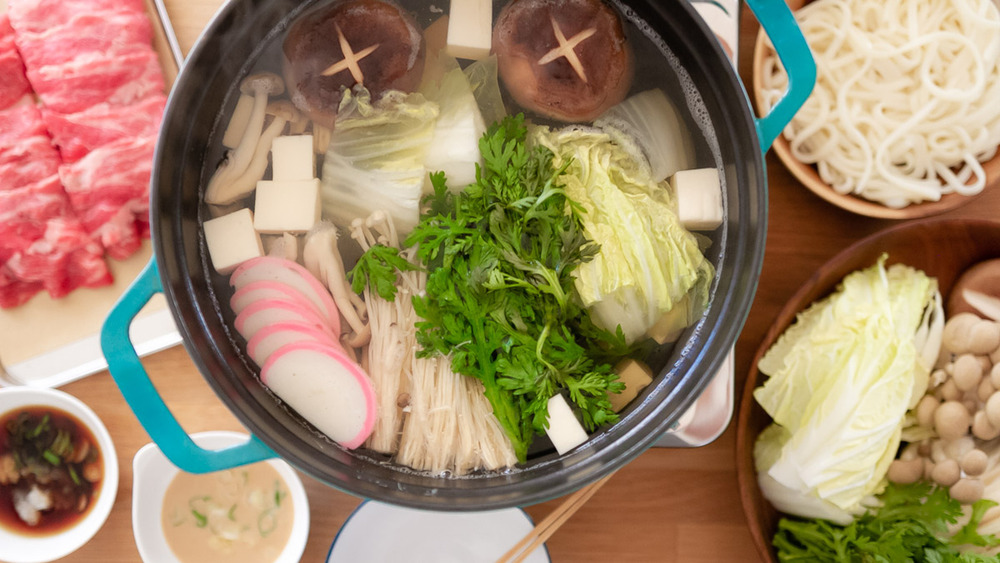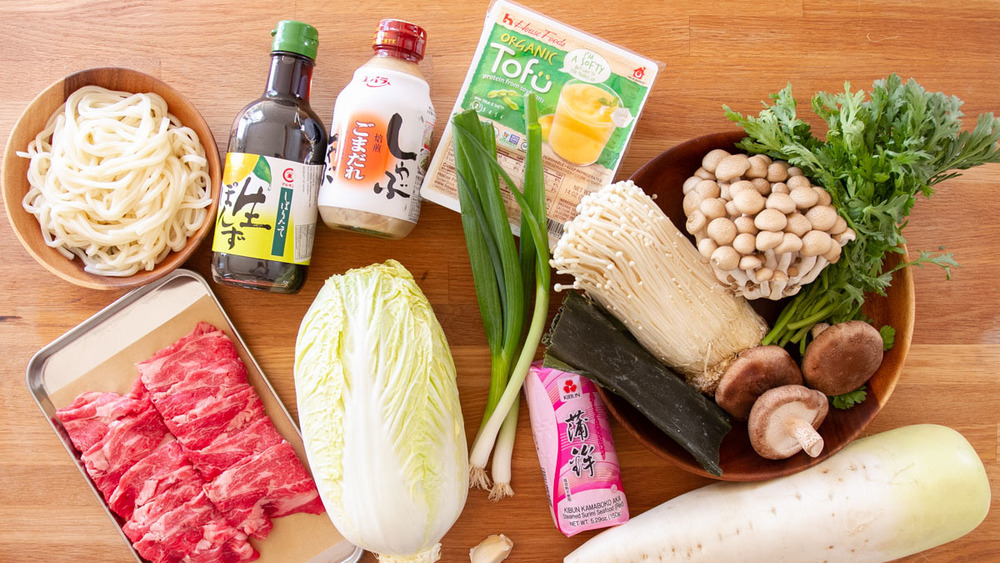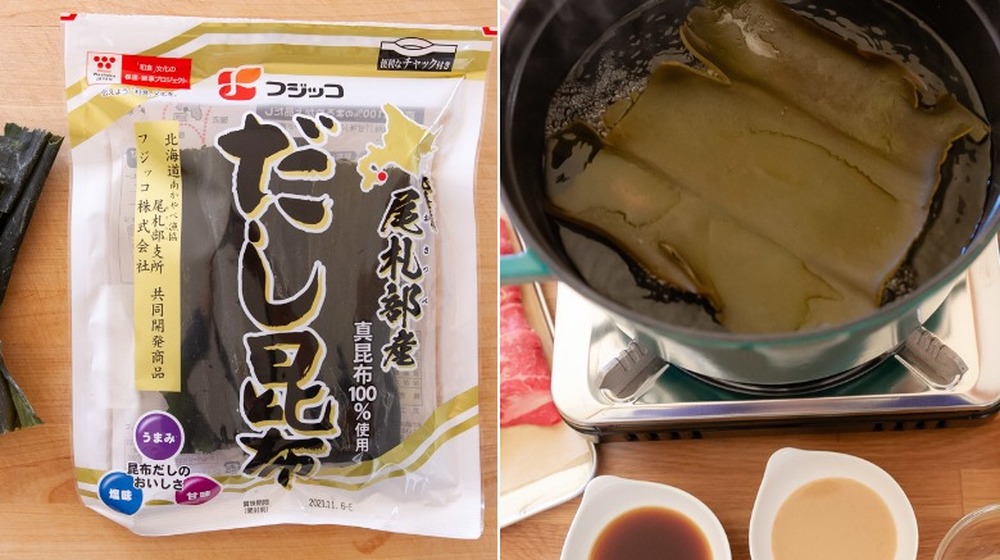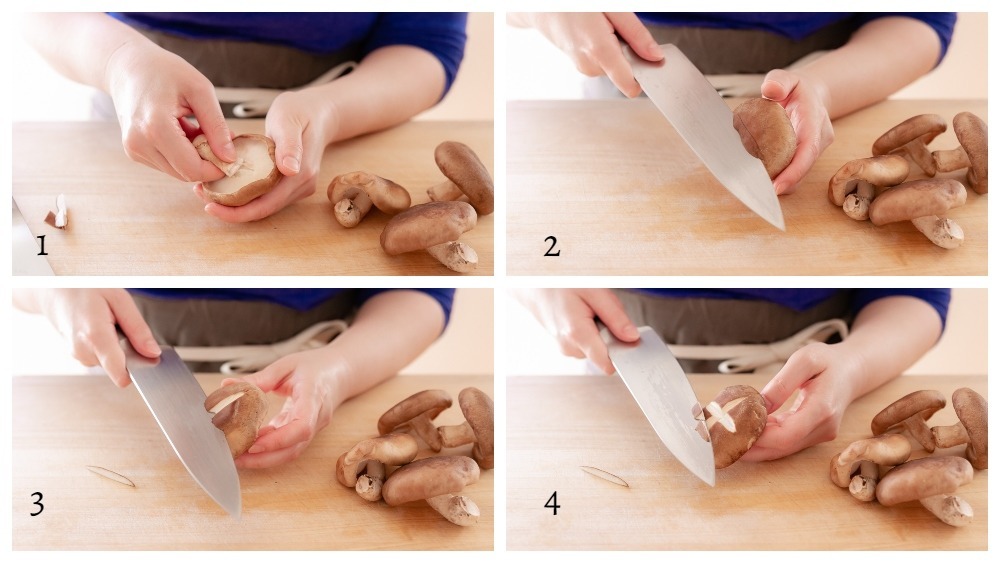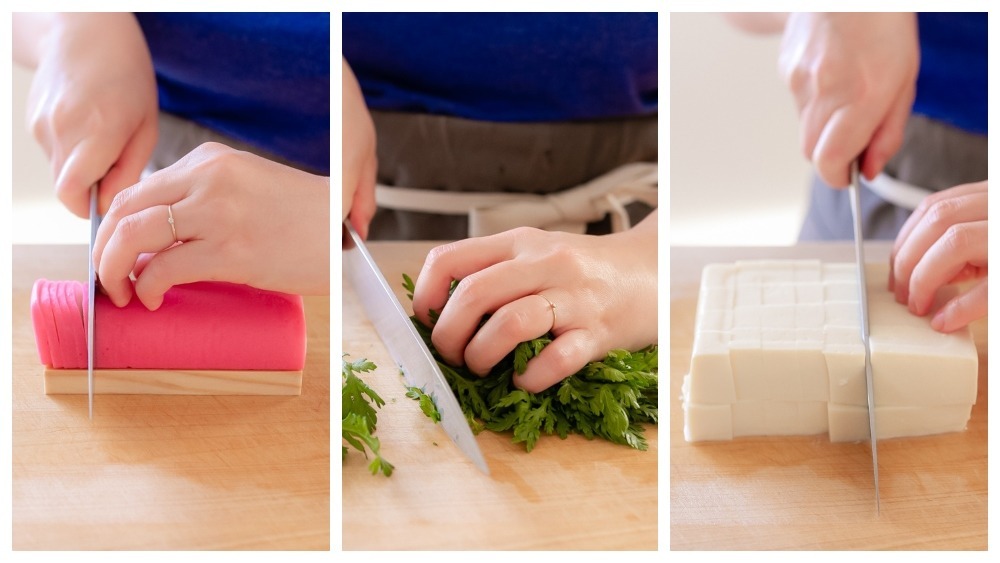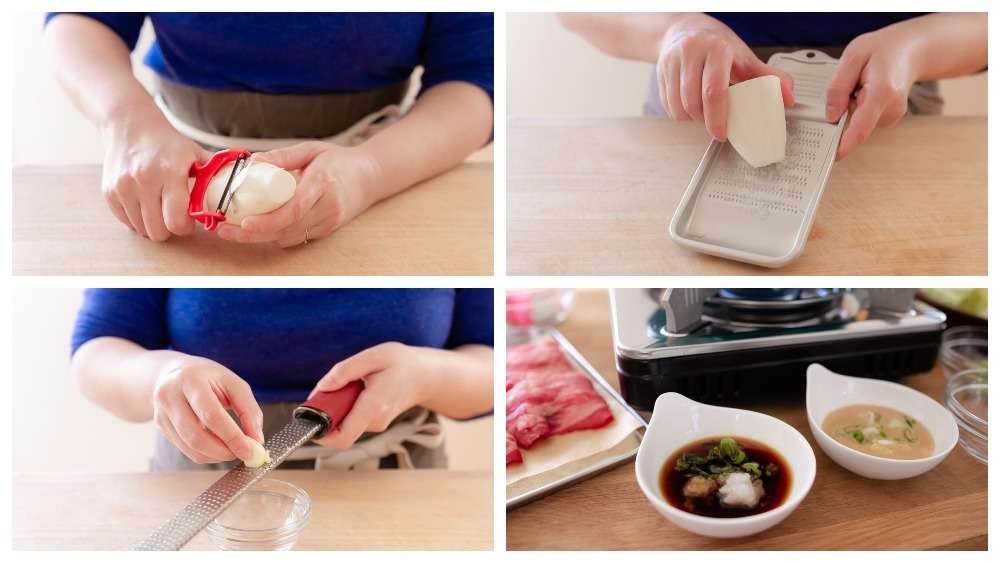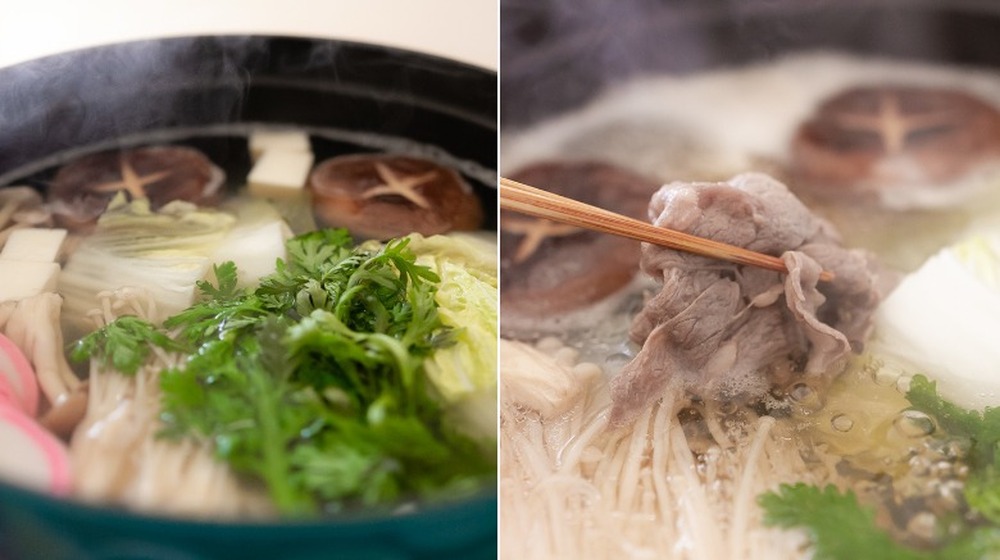Easy Shabu Shabu Recipe
Shabu shabu is a type of a hot pot meal that's meant to be enjoyed with family and friends for celebrations, holidays, or simple get-togethers. Shabu shabu is the ultimate communal dish since everyone cooks together at the dining table. The developer of this easy recipe is chef and nutritionist Cindy Chou, whose blog, Healthy Feels, guides readers in creating plant-forward Taiwanese and other Asian-inspired dishes.
"Shabu shabu and hot pot in general are my favorite foods," Chou told us. "I really enjoy the sharing experience with loved ones. It's a great way to slow down and appreciate the food and each other's company." Almost all of Chou's recipe is simple preparation — slicing and chopping veggies — because the big pot is set in the center of the table, and guests do the cooking themselves by dipping the thinly sliced beef (or other protein) into the steaming kombu (dried kelp) broth. Shabu shabu is not only delicious and healthy, but it's also fun. Prep time is only 15 minutes, so you can make Chou's shabu shabu in no time at all any night of the week.
Gather together the ingredients for this easy shabu shabu
Some of the ingredients for Chou's shabu shabu can be found in most supermarkets — for example, scallions, tofu, udon noodles, Napa cabbage, and ponzu sauce. Other ingredients can be sourced at any Asian grocery store.
Chou uses beef in her recipe, and you can find it pre-sliced at an Asian market under the names "shabu shabu," "sukiyaki," or simply "hot pot." Shabu shabu can also be made with pork, shrimp, clams, or sliced fish filets. As for the sesame sauce, Chou recommends looking for one that is specifically made for shabu shabu: "It may be labeled "goma dare," Chou said. "Japanese stores will usually have sesame sauces in two different sections: one for sesame dressings and one for shabu shabu. My go-to brand is Ebara Foods."
Two other ingredients that you'll most likely find only at an Asian market are chrysanthemum greens and kamaboko, a very popular steamed fish cake. Don't be put off by these unfamiliar ingredients. Think of it as a culinary adventure!
Make the kombu broth for the shabu shabu
The main base for all shabu shabu is the broth, and it's always made with kombu, which is dried kelp. It's a bit salty like the ocean with a green-grass flavor. The preparation of kombu for shabu shabu is simple. Break the kombu into pieces that are three or four inches long, and put them in a pot with three quarts of water. Heat the water until it's just about to boil, then turn down the heat to low, and let the broth simmer.
While it's simmering, you'll get the vegetables and udon noodles ready. For the udon, bring a small pot of water to the boil, and drop the frozen udon in. They'll loosen and separate in one to two minutes. Drain the noodles in a fine mesh strainer, then rinse them under running cold water. Set the udon aside on a small serving dish.
Prepare the shiitake mushrooms for this easy shabu shabu
Chou uses three types of mushrooms: enoki, shiitake, and beech. If you can't find beech mushrooms, Chou recommends king trumpet, although the flavor will be different. You could add more enoki and shiitake. The enoki and beech mushrooms don't need much preparation: Wash and dry them, cut off the ends, and break them up by hand into small chunks. Chou gives a nice presentational touch to the shiitake mushrooms, and since there are only five shiitake, it will only take you a few minutes to prep them.
This is an optional step, but it will give your shabu shabu a professional look. First, gently twist of the stem from each of the shiitake cap. Place each mushroom cap-side up on a cutting board or, as Chou does, hold the cap in the palm of your non-dominant hand. Make two shallow v-shaped cuts down the middle of the cap, then remove that portion you've just cut so that the white flesh of the shiitake is revealed. Rotate the mushroom cap 90 degrees, and cut two more V-shaped cuts down the middle, which will give you a lovely four-point flower design.
Slice the fishcake and tofu and chop the chrysanthemum greens
Kamaboko is so popular in Japan that there's a museum devoted to its history and preparation, and you can even learn to make it yourself. It's often made from a paste of pureed surimi — the white fish that's a stand-in for real crabmeat – which is shaped into a log, colored, and steamed. Kamaboko is used in many Japanese dishes, and Chou adds it to her shabu shabu recipe.
Simply slice a quarter of the package into 1/8-inch thick slices, and set them on a large serving platter. Next, chop up the chrysanthemum greens into roughly three-inch pieces, and set them aside. You'll be adding them to the shabu shabu just before serving so they won't overcook.
Drain the silken tofu, and slice it in half lengthwise. Then slice the two halves together into strips that are one inch wide, and cut the strips into one-inch cubes. Add the tofu cubes to the serving platter. Shabu shabu can also be made with different types of tofu, such as medium-firm or fried tofu. Finally, cut the five leaves of Napa cabbage into two-inch pieces (wider pieces can be cut in half), and put them on the platter.
Make the two dipping sauces for this easy shabu shabu
Shabu shabu is traditionally served with dipping sauces, which, as Chou told us, "with the light broth allow you to savor the flavors of the ingredients and make the meal easily customizable to individual preferences." To make the sauces, first divide the ponzu and sesame sauce into separate sauce dishes for each person. For the ponzu, peel and grate daikon radish and grated garlic, and add them to the ponzu with thinly sliced scallions. For the sesame sauce, add more grated garlic and daikon to taste. With the sauces done, set the table with a countertop burner, the platter with the shabu shabu ingredients (arrange the beef on a separate platter), the sauces, chopsticks or tongs, individual bowls, and utensils for each person.
Heat the kombu broth and other ingredients, and serve the shabu shabu
Place the pot of kombu broth on the tabletop burner, and heat the broth over medium heat. Add small portions of the mushrooms, tofu, fish cake, and Napa cabbage. Hold off on adding the chopped chrysanthemum greens until right before serving, or they'll overcook.
When everyone's at the table and they're ready to cook the beef, stir in the chrysanthemum greens. To serve, each person uses communal chopsticks to cook the beef slices by dipping them into the hot broth for 30 seconds until they're no longer pink. Transfer the beef to individual bowls, and pick out the other shabu shabu ingredients, adding more from the prepared platter as needed.
When everything is mostly cooked, reheat the udon noodles in the broth, and serve them with broth in everyone's bowls. To eat, dip the shabu shabu into the two sauces. Chou recommends dipping the beef and shiitake mushrooms into the sesame sauce and everything else in the ponzu. Shabu shabu is all about sharing, and this recipe is so easy, you'll want to make it for every special gathering.
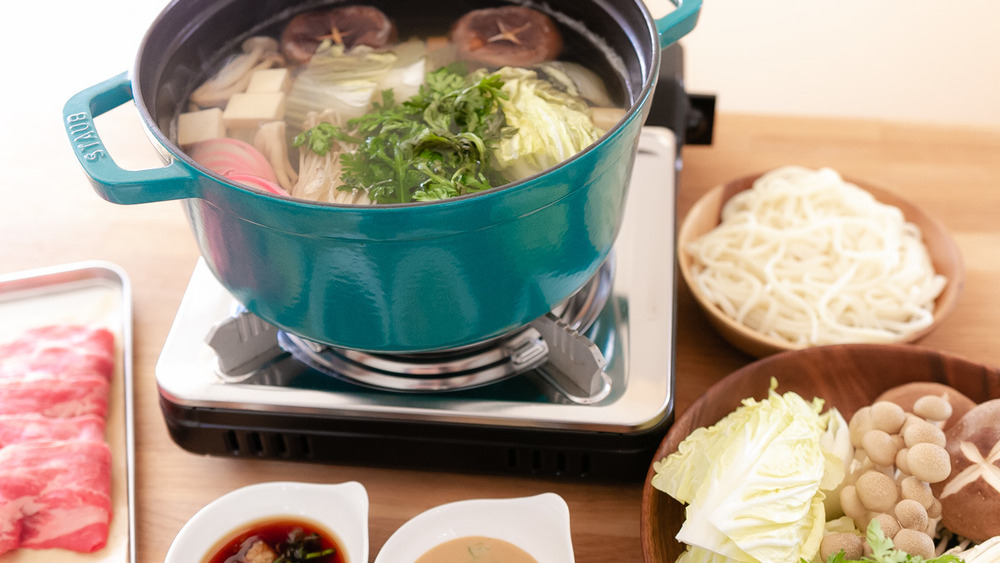
- 3 quarts water
- 1 piece kombu (dried kelp), about 3 inches x 4 inches
- 9 ounces frozen udon noodles
- 5 shiitake mushrooms
- 1 package enoki mushrooms, ends cut off and separated into smaller chunks by hand
- 1 package beech (shimeji) mushrooms, ends cut off and separated into smaller chunks by hand
- 5 Napa cabbage leaves, cut into 2-inch pieces (wider pieces can be cut in half)
- 1 medium bunch chrysanthemum greens, roughly cut into 3-inch pieces
- 1 package silken tofu (14 ounces), drained and cut into 1-inch cubes
- ¼ package kamaboko (Japanese fish cake), cut into ⅛ of an inch-thick slices
- 1 pound thinly sliced beef ribeye or chuck
- ¾ cup ponzu sauce, divided
- ¾ cup sesame sauce (goma dare), divided
- 1 clove garlic, peeled and grated
- 2 ½-inch daikon radish, peeled, grated
- 3 scallions, ends removed and thinly sliced
- Add water and kombu to a medium 4-quart pot. Heat until the broth is just about to boil, and turn down to simmer over low heat. While the broth is simmering, prepare the other ingredients.
- Boil a small pot of water for the udon. Place frozen udon in the boiling water until the noodles loosen up (1 to 2 minutes). Strain the noodles and cool by rinsing with cold water. Set aside drained noodles on a small serving dish.
- De-stem shiitake mushrooms, and cut decorative patterns on the tops.
- Place prepared mushrooms, vegetables, tofu, and fish cake on a large serving platter.
- Place beef on a separate serving platter.
- Prepare dipping sauces by dividing ponzu and sesame sauces into separate sauce dishes for each person. For the ponzu sauce, add grated garlic, daikon, and sliced scallions to taste. For the sesame sauce, add grated garlic and daikon to taste.
- Set the table with a countertop burner, the shabu shabu ingredients, sauces, and communal chopsticks or tongs, a small bowl, and utensils for each person.
- Heat the pot of kombu broth on the countertop burner over medium heat and add a small portion of the mushrooms, tofu, fish cake, and Napa cabbage to start. Cook the chrysanthemum greens right before eating to prevent them from overcooking.
- When you're ready to eat the beef, quickly cook individual slices of beef in the broth using a pair of communal chopsticks as you eat. Cook each slice just until the beef is no longer pink (about 30 seconds). Remove other cooked ingredients from the pot with communal chopsticks and place them in your bowl for cooling if desired.
- Dip cooked ingredients in your sauce of choice to eat. Add more ingredients to the pot as needed.
- When most of the ingredients are cooked, you can reheat the udon noodles in the broth for 1 minute. Divide the cooked udon noodles into each person's bowl, add some broth to the noodles, and season with ponzu sauce or a dash of salt.
